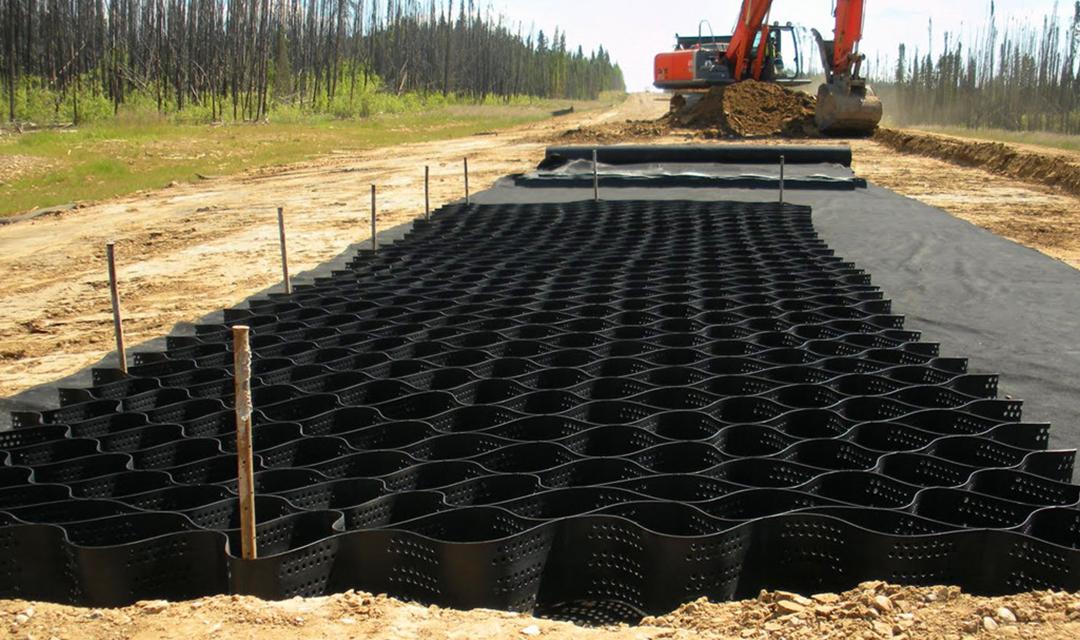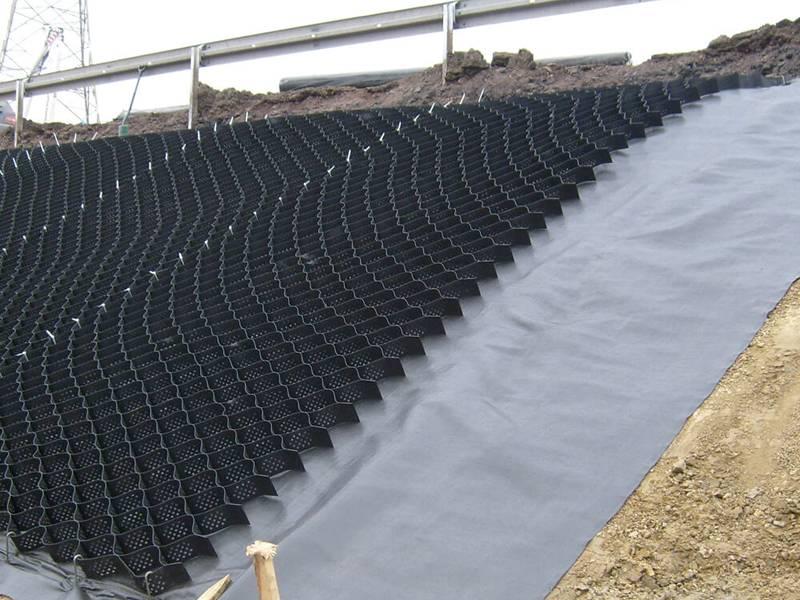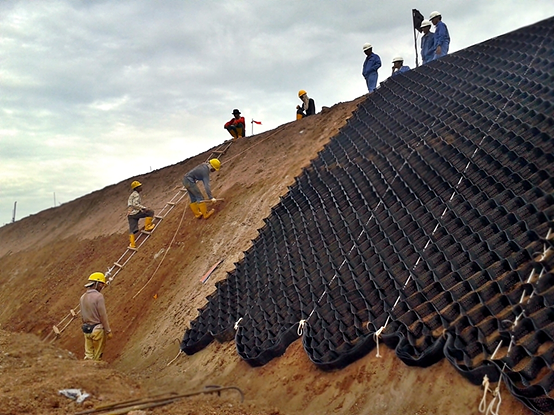I. Definition of ecological slope protection
Ecological slope protection is a slope protection technology that integrates the basic knowledge of engineering mechanics, soil science, ecology and botany to support slopes or side slopes, forming an integrated slope protection system composed of plants or engineering and plants.
After the excavated slope is formed, the slope is protected and reinforced by planting plants, using the interaction between plants and the rock and soil (root anchoring), so that it can meet the requirements for the stability of the surface layer of the slope, but also restore the damaged natural ecological environment, which is an effective means of slope protection and stabilisation.
II. Functions of ecological berms
(1) Slope protection function: the vegetation has a deep-rooted anchoring and shallow-rooted reinforcement effect.
(2) Prevention of soil erosion: reduces pore water pressure on slopes, traps rainfall, weakens splash erosion and controls soil loss.
(3) Improve environmental functions: vegetation can restore damaged ecological environment, promote the degradation of organic pollutants, purify air and regulate microclimate.
III. Forms of ecological berms
Commonly used forms of ecological slope protection include plant-based slope protection, geotechnical material composite planting base slope protection, ecological gabion slope protection, vegetated ecological concrete slope protection, ecological bag slope protection, porous structure slope protection, self-embedded retaining wall slope protection, etc.
(1) Plant-based berms.
By planting vegetation on the slope, the mechanical (deep root anchoring and shallow root reinforcement) and hydrological (pore pressure reduction, erosion weakening and runoff control) effects of the plant's developed root system are used to stabilise the slope and prevent erosion, while meeting the ecological needs of the landscape.
Benefits: Mainly used in small and medium-sized rivers and lakes and harbours with gentle flow conditions. The plants should be acid and alkaline tolerant, high temperature and drought resistant, with a well-developed root system, fast growth, long green period, high survival rate, economical price, easy management and resistance to pests and diseases.
Disadvantages: weak resistance to scouring.
(2) Geomaterial composite planting base slope protection.
There are 3 types of berm in this category.
a. Geomesh matting
planting base slope protection: mainly composed of 3 parts: netting, planting soil and grass seed.
Advantages:
1. good soil consolidation;
2. good resistance to scouring;
3. economical and environmentally friendly.
Disadvantages:
1. Resistance to storm washing is still weak, depending on the growth of the plants;
2. The technique is not applicable near and below the water level.
b. Geocell:
Geocell is made by using polypropylene and other sheet materials, which are hot-fused and bonded into a honeycomb mesh.
Advantages:
1. Lightweight, abrasion resistant, ageing resistant, tough, impact resistant, easy to transport.
2. Easy to construct and can be used many times.
Disadvantages:
the slope of the river should not be too steep, the current should not be too fast and the water level should not change too much.
c. Geogrids:
Geogrids are two-dimensional grids or three-dimensional grids with a certain height made of polypropylene, polyethylene and other polymers by thermoplastic or moulding, which are called geogrids in civil engineering. Geogrids are divided into four categories: plastic geogrids, steel geogrids, glass geogrids and glass fibre polyester geogrids.
Advantages:
1. Strong anti-scouring ability, can effectively prevent the collapse of river banks;
2. Low cost, easy transportation, simple construction, short construction period;
3. Geogrid is ageing resistant, high and low temperature resistant.
Disadvantages:
when exposed to the sun, geogrids can shorten their service life; some polypropylene geogrids can burn when exposed to fire.
(3) Ecological gabion slope protection.
Gabion mesh is a box-shaped structure made of high corrosion resistance, high strength and ductility low carbon steel wire wrapped with PVC material and then woven by machinery. It can be divided into gabion slope protection, Reynolds slope protection, alloy mesh pocket, etc. according to the shape of the material.
Advantages:
1. strong integrity, water permeability, scour resistance and ecological suitability;
2. wide application;
3. beneficial to the growth of natural plants, so that the bank environment can be improved;
4. low cost, economical and easy to transport.
Disadvantages:
As the main body of the berm is mainly filled with stones, a large amount of stone is required, so it is not very suitable in plain areas; timely remediation is required after the partial breakage of the interbank to avoid the leakage of internal stones, which affects the stability of the bank.
(4) Vegetated ecological concrete berms.
Ecoconcrete is a new material with properties between those of ordinary concrete and cultivated soil, consisting of porous concrete, water retention materials, slow-release fertiliser and topsoil.
Advantages:
1. Provide substrate for plant growth;
2. Good anti-erosion performance;
3. The slope protection has a high porosity, which provides a breeding place for animals and microorganisms;
4. The high air permeability of the material ensures the moisture and heat exchange capacity between the protected soil and the air to a large extent.
Disadvantages:
1. alkali reduction treatment problems;
2.strength and durability need to be verified;
3. reseedability needs to be further verified;
4. high price of berms.
(5) Ecological bag slope protection.
Ecological bags are made by using special machinery and equipment, according to a specific production process, fertiliser, grass seeds and water retention agents are planted on naturally degradable non-woven fabrics or other materials at a certain density, and are rolled and needled by machines to form the product.
Advantages:
1. high stability;
2. permeable and impermeable filtering function;
3. fast recovery of the ecosystem;
4. simple and fast construction.
Disadvantages:
1. easy to aging, ecological bag plant seed regeneration problems.
2. ecological bag pore too large bag easy in the water wash out of the bag, resulting in subsidence, affecting the stability of the slope;
(6) Porous structural berms.
Porous structure slope protection is a type of slope protection using porous bricks for grassing, common porous bricks include eight-letter bricks, six-pronged slope protection grid bricks and so on. This porous structure with continuous penetration provides a good living space and habitat for plants and animals, and allows for energy exchange between land and water, making it a kind of "breathing" berm. At the same time, the coiled roots of the dioecious plant system are organically integrated with the slope, forming an anchoring effect on the foundation slope, which also has the effect of air permeability, water permeability, soil retention and slope stabilisation.
Advantages:
1. Different forms of porous bricks can be chosen according to different needs;
2. The pores of the porous bricks can be used for planting, and the submerged part can also be used as a habitat for fish and shrimps;
3. Strong water circulation and resistance to scouring.
Disadvantages:
1. The slope of the embankment must not be too large, otherwise the porous bricks will easily slip into the river; 2. The embankment must be strong and the soil must be compacted and compacted, otherwise it will easily form a depression zone after the river water keeps washing away;
3. High cost and large construction workload;
4. Not suitable for sandy soils, not suitable for river channels with many bends in the river bank.
(7) Self-embedded retaining wall slope protection.
The core material of a self-embedded retaining wall is the self-embedded block. This type of retaining wall is a gravity structure which relies on the self-weight of the self-embedded blocks to resist dynamic and static loads and to stabilise the slope; at the same time, it does not require mortar masonry and relies on the locking function of the self-embedded blocks with trailing edges and their own weight to prevent sliding and overturning. The stability of the entire wall can be improved by adding glass fibre geogrid. Plants can be artificially planted between the pore spaces to enhance the aesthetics of the retaining wall.
Advantages:
1. strong flood protection capacity;
2. pore space provides good habitat for fish and shrimps;
3. material saving;
4. variable shape, mainly curved, straight, landscape and vegetation type, to meet the needs of different riverbank form;
5. low requirements for the foundation;
6. good seismic performance;
7. easy construction, no noise construction, easy to remove later.
Disadvantages:
1. The soil behind the wall is easily carried away by the water, resulting in a hollow behind the wall, which affects the stability of the structure and can easily lead to the collapse of the wall when the water is too fast;
2. This type of revetment is mainly suitable for straight rivers, but not for rivers with too much curvature;
3. The bend requires a large amount of stone and tends to create a convex angle where the impact of the water is greater, making the use of this type of revetment somewhat risky.




